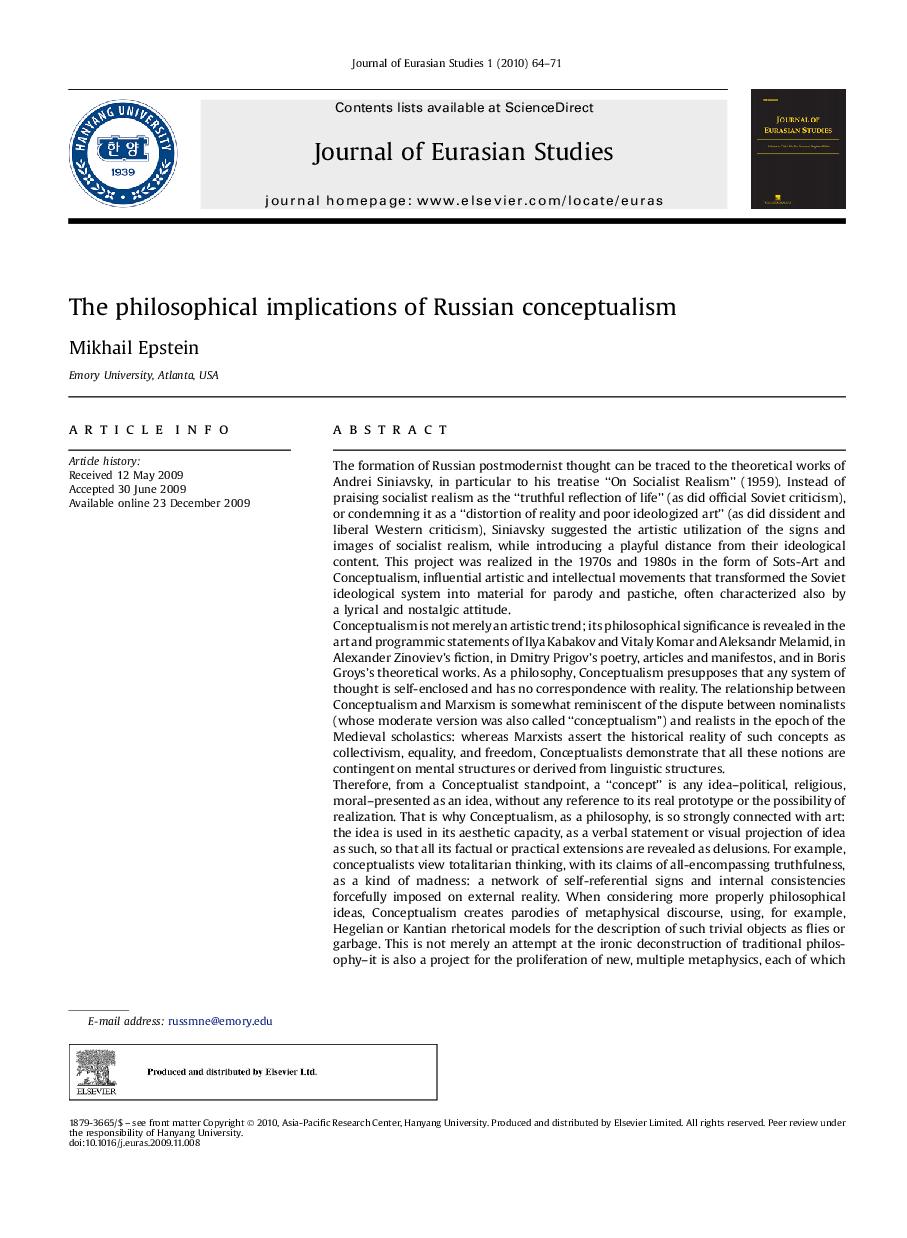| Article ID | Journal | Published Year | Pages | File Type |
|---|---|---|---|---|
| 1127339 | Journal of Eurasian Studies | 2010 | 8 Pages |
The formation of Russian postmodernist thought can be traced to the theoretical works of Andrei Siniavsky, in particular to his treatise “On Socialist Realism” (1959). Instead of praising socialist realism as the “truthful reflection of life” (as did official Soviet criticism), or condemning it as a “distortion of reality and poor ideologized art” (as did dissident and liberal Western criticism), Siniavsky suggested the artistic utilization of the signs and images of socialist realism, while introducing a playful distance from their ideological content. This project was realized in the 1970s and 1980s in the form of Sots-Art and Conceptualism, influential artistic and intellectual movements that transformed the Soviet ideological system into material for parody and pastiche, often characterized also by a lyrical and nostalgic attitude.Conceptualism is not merely an artistic trend; its philosophical significance is revealed in the art and programmic statements of Ilya Kabakov and Vitaly Komar and Aleksandr Melamid, in Alexander Zinoviev's fiction, in Dmitry Prigov's poetry, articles and manifestos, and in Boris Groys's theoretical works. As a philosophy, Conceptualism presupposes that any system of thought is self-enclosed and has no correspondence with reality. The relationship between Conceptualism and Marxism is somewhat reminiscent of the dispute between nominalists (whose moderate version was also called “conceptualism”) and realists in the epoch of the Medieval scholastics: whereas Marxists assert the historical reality of such concepts as collectivism, equality, and freedom, Conceptualists demonstrate that all these notions are contingent on mental structures or derived from linguistic structures.Therefore, from a Conceptualist standpoint, a “concept” is any idea–political, religious, moral–presented as an idea, without any reference to its real prototype or the possibility of realization. That is why Conceptualism, as a philosophy, is so strongly connected with art: the idea is used in its aesthetic capacity, as a verbal statement or visual projection of idea as such, so that all its factual or practical extensions are revealed as delusions. For example, conceptualists view totalitarian thinking, with its claims of all-encompassing truthfulness, as a kind of madness: a network of self-referential signs and internal consistencies forcefully imposed on external reality. When considering more properly philosophical ideas, Conceptualism creates parodies of metaphysical discourse, using, for example, Hegelian or Kantian rhetorical models for the description of such trivial objects as flies or garbage. This is not merely an attempt at the ironic deconstruction of traditional philosophy–it is also a project for the proliferation of new, multiple metaphysics, each of which consciously demonstrates the contingency of its central concept, be it Absolute Spirit in Hegel or a fly in Kabakov. Postmodernism is often criticized for its aestheticism and moral indifference, but Russian conceptualists emphasize the moral implications of metaphysical contingency, which undermines totalitarian and hegemonic discourse and promotes self-irony as a mode of humility.Conceptualism identifies itself as a predominantly Russian-Soviet mode of thinking. In the West, the correlation between ideological signs and observable reality has been persistently validated through scientific and economic practice; while in Russia, traditionally, reality itself has been constructed from ideological signs generated by its ruling minds as a kind of hyper-reality. Thus, Russian Conceptualism sees itself not as a mere replica of Western postmodernism, but as a reflection of the underlying structures of Russian history, where the signs of reality have always been subject to ideological manipulation.
